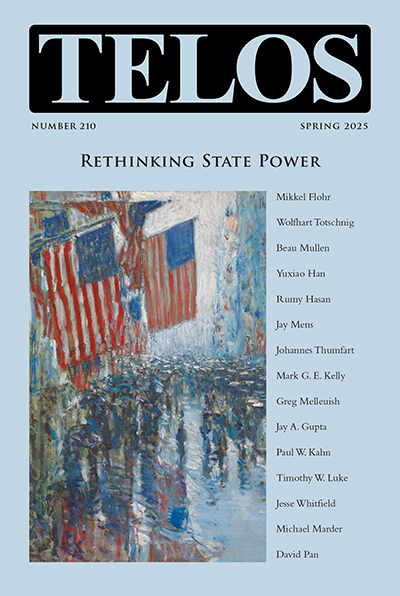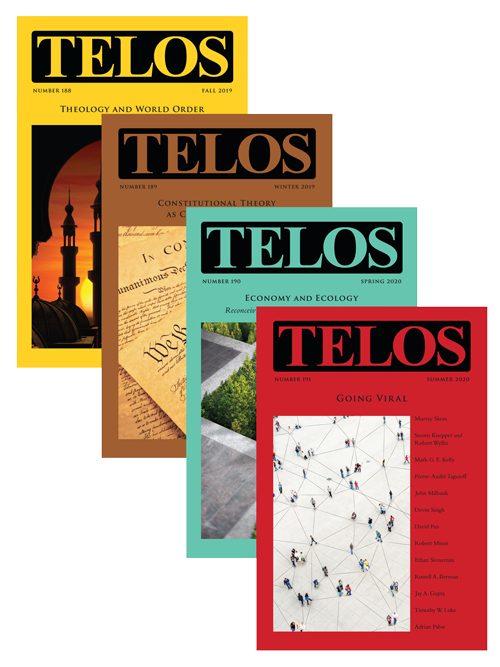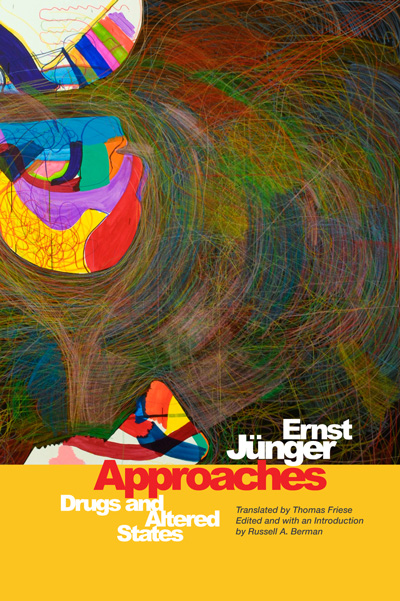By Johanna K. Schenner · Wednesday, September 17, 2014 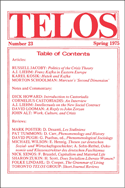 In “Franz Kafka in Eastern Europe,” Antonin J. Liehm addresses the impact of Kafka on both the communist literary sphere and the regime following the May 1963 Liblice Conference, an international symposium dealing with Kafka’s life and work. At first glance, this symposium does not appear to be remarkable: Kafka, known for such works as “The Metamorphosis” (1915) and “The Castle” (1926), was born in Prague in 1883, and he worked there as a lawyer before dying in 1924 in the sanatorium at Kierling, located in Klosterneuburg, Austria. Nonetheless, the symposium revealed that the socialist regimes were less totalitarian than supposed, if only for a short time, and it also attributed to Kafka a significant role in the beginning of cultural democratization, which then spread to other spheres. In “Franz Kafka in Eastern Europe,” Antonin J. Liehm addresses the impact of Kafka on both the communist literary sphere and the regime following the May 1963 Liblice Conference, an international symposium dealing with Kafka’s life and work. At first glance, this symposium does not appear to be remarkable: Kafka, known for such works as “The Metamorphosis” (1915) and “The Castle” (1926), was born in Prague in 1883, and he worked there as a lawyer before dying in 1924 in the sanatorium at Kierling, located in Klosterneuburg, Austria. Nonetheless, the symposium revealed that the socialist regimes were less totalitarian than supposed, if only for a short time, and it also attributed to Kafka a significant role in the beginning of cultural democratization, which then spread to other spheres.
Continue reading →
By Beau Mullen · Wednesday, January 22, 2014 As an occasional feature on TELOSscope, we highlight a past Telos article whose critical insights continue to illuminate our thinking and challenge our assumptions. Today, Beau Mullen looks at Martin Jay’s “Hierarchy and the Humanities: The Radical Implications of a Conservative Idea” from Telos 62 (Winter 1984).
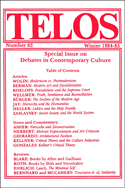 The notion of “high culture” has been under attack in different ways by critics, academics, and the general public for generations. Moreover, as Western culture becomes increasingly commercialized, egalitarian impulses have exiled much of what was considered by many to be high culture to obscurity, appreciated mainly by a minority who are themselves regarded as cultural elitists. Popular or mass culture appears to now reign supreme, but this does not mean that cultural hierarchy has been brought to an end. Cultural hierarchy still has its defenders, and as Martin Jay suggests in his 1984 Telos article “Hierarchy and the Humanities: The Radical Implications of a Conservative Idea,” it clearly has a place in current cultural evaluations. The notion of “high culture” has been under attack in different ways by critics, academics, and the general public for generations. Moreover, as Western culture becomes increasingly commercialized, egalitarian impulses have exiled much of what was considered by many to be high culture to obscurity, appreciated mainly by a minority who are themselves regarded as cultural elitists. Popular or mass culture appears to now reign supreme, but this does not mean that cultural hierarchy has been brought to an end. Cultural hierarchy still has its defenders, and as Martin Jay suggests in his 1984 Telos article “Hierarchy and the Humanities: The Radical Implications of a Conservative Idea,” it clearly has a place in current cultural evaluations.
Continue reading →
By Sean Franzel · Thursday, July 19, 2012 Sean Franzel’s “Toward an Anti-Monumental Literary-Critical Style: Notes on Benjamin and Jean Paul” appears in Telos 159 (Summer 2012). Read the full version online at the Telos Online website, or purchase a print copy of the issue here.
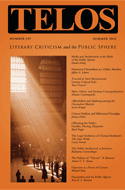 This essay— modest notes rather than a systematic exploration of the problem of critical style— examines certain striking similarities between the critical vocabularies of Jean Paul and Walter Benjamin. In rejecting heroic conceptions of individual authorship, both writers treat the personal lives of literary figures as phenomena of larger significance, and both seek to undermine metaphors of monumentality. Through readings of Jean Paul’s 1804 Vorschule der Ästhetik (School of Aesthetics) and Benjamin’s pseudonymously published 1936 anthology Deutsche Menschen (German Men and Women), this essay argues that both writers remind us of the decidedly human sides of literary and critical life: of the weaknesses and limitations of this life, that is to say, as well as its potential for ethical direction. This essay— modest notes rather than a systematic exploration of the problem of critical style— examines certain striking similarities between the critical vocabularies of Jean Paul and Walter Benjamin. In rejecting heroic conceptions of individual authorship, both writers treat the personal lives of literary figures as phenomena of larger significance, and both seek to undermine metaphors of monumentality. Through readings of Jean Paul’s 1804 Vorschule der Ästhetik (School of Aesthetics) and Benjamin’s pseudonymously published 1936 anthology Deutsche Menschen (German Men and Women), this essay argues that both writers remind us of the decidedly human sides of literary and critical life: of the weaknesses and limitations of this life, that is to say, as well as its potential for ethical direction.
Telos 140: Peter Szondi and Critical Hermeneutics is available in our store.
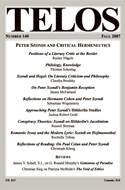 Literature has been a long-standing, if sometimes hidden, topic for Telos. While the journal has ostensibly focused on social and political theory, in various traditions and stretching from philosophy to culture, matters of literature have frequently percolated between the lines. This interlinear presence has certainly been the case for our engagements with those thinkers who made major contributions to literary and aesthetic theory, such as Adorno, as well as Baudrillard, Benjamin, Goldmann, Gramsci, and Lukács, but more broadly to the wide-ranging efforts to interpret and reinterpret works of the past: Telos has been about rereading, recovering, and reinterpreting parts of the intellectual legacy with reference to questions of current urgency. While the journal did succeed in keeping a healthy distance of common sense from the vanity fair of “literary theory” that gripped the universities during the 1980s and 1990s, our interest in mapping alternatives to the mentalities of bureaucracy—traditions, communities, the life-world, and religion—also indicated an underlying interest in literature, as well as in the arts in general. This testifies, of course, to the legacy of Critical Theory and the effort to correct the dominance of instrumental reason with an aesthetic dimension; but there is a much bigger picture, beyond the specific confines of Critical Theory per se, the pursuit of a richer life and a resistance to all the cultural and social forces that degrade human creativity and freedom, whether one attributes them to modernity or to conditions of longer duration. As a vehicle that can enhance imagination and expressivity, literature turns out to be indispensable. Literature has been a long-standing, if sometimes hidden, topic for Telos. While the journal has ostensibly focused on social and political theory, in various traditions and stretching from philosophy to culture, matters of literature have frequently percolated between the lines. This interlinear presence has certainly been the case for our engagements with those thinkers who made major contributions to literary and aesthetic theory, such as Adorno, as well as Baudrillard, Benjamin, Goldmann, Gramsci, and Lukács, but more broadly to the wide-ranging efforts to interpret and reinterpret works of the past: Telos has been about rereading, recovering, and reinterpreting parts of the intellectual legacy with reference to questions of current urgency. While the journal did succeed in keeping a healthy distance of common sense from the vanity fair of “literary theory” that gripped the universities during the 1980s and 1990s, our interest in mapping alternatives to the mentalities of bureaucracy—traditions, communities, the life-world, and religion—also indicated an underlying interest in literature, as well as in the arts in general. This testifies, of course, to the legacy of Critical Theory and the effort to correct the dominance of instrumental reason with an aesthetic dimension; but there is a much bigger picture, beyond the specific confines of Critical Theory per se, the pursuit of a richer life and a resistance to all the cultural and social forces that degrade human creativity and freedom, whether one attributes them to modernity or to conditions of longer duration. As a vehicle that can enhance imagination and expressivity, literature turns out to be indispensable.
Continue reading →
|
|
 In “Franz Kafka in Eastern Europe,” Antonin J. Liehm addresses the impact of Kafka on both the communist literary sphere and the regime following the May 1963 Liblice Conference, an international symposium dealing with Kafka’s life and work. At first glance, this symposium does not appear to be remarkable: Kafka, known for such works as “The Metamorphosis” (1915) and “The Castle” (1926), was born in Prague in 1883, and he worked there as a lawyer before dying in 1924 in the sanatorium at Kierling, located in Klosterneuburg, Austria. Nonetheless, the symposium revealed that the socialist regimes were less totalitarian than supposed, if only for a short time, and it also attributed to Kafka a significant role in the beginning of cultural democratization, which then spread to other spheres.
In “Franz Kafka in Eastern Europe,” Antonin J. Liehm addresses the impact of Kafka on both the communist literary sphere and the regime following the May 1963 Liblice Conference, an international symposium dealing with Kafka’s life and work. At first glance, this symposium does not appear to be remarkable: Kafka, known for such works as “The Metamorphosis” (1915) and “The Castle” (1926), was born in Prague in 1883, and he worked there as a lawyer before dying in 1924 in the sanatorium at Kierling, located in Klosterneuburg, Austria. Nonetheless, the symposium revealed that the socialist regimes were less totalitarian than supposed, if only for a short time, and it also attributed to Kafka a significant role in the beginning of cultural democratization, which then spread to other spheres.  The notion of “high culture” has been under attack in different ways by critics, academics, and the general public for generations. Moreover, as Western culture becomes increasingly commercialized, egalitarian impulses have exiled much of what was considered by many to be high culture to obscurity, appreciated mainly by a minority who are themselves regarded as cultural elitists. Popular or mass culture appears to now reign supreme, but this does not mean that cultural hierarchy has been brought to an end. Cultural hierarchy still has its defenders, and as Martin Jay suggests in his 1984 Telos article “Hierarchy and the Humanities: The Radical Implications of a Conservative Idea,” it clearly has a place in current cultural evaluations.
The notion of “high culture” has been under attack in different ways by critics, academics, and the general public for generations. Moreover, as Western culture becomes increasingly commercialized, egalitarian impulses have exiled much of what was considered by many to be high culture to obscurity, appreciated mainly by a minority who are themselves regarded as cultural elitists. Popular or mass culture appears to now reign supreme, but this does not mean that cultural hierarchy has been brought to an end. Cultural hierarchy still has its defenders, and as Martin Jay suggests in his 1984 Telos article “Hierarchy and the Humanities: The Radical Implications of a Conservative Idea,” it clearly has a place in current cultural evaluations.  This essay— modest notes rather than a systematic exploration of the problem of critical style— examines certain striking similarities between the critical vocabularies of Jean Paul and Walter Benjamin. In rejecting heroic conceptions of individual authorship, both writers treat the personal lives of literary figures as phenomena of larger significance, and both seek to undermine metaphors of monumentality. Through readings of Jean Paul’s 1804 Vorschule der Ästhetik (School of Aesthetics) and Benjamin’s pseudonymously published 1936 anthology Deutsche Menschen (German Men and Women), this essay argues that both writers remind us of the decidedly human sides of literary and critical life: of the weaknesses and limitations of this life, that is to say, as well as its potential for ethical direction.
This essay— modest notes rather than a systematic exploration of the problem of critical style— examines certain striking similarities between the critical vocabularies of Jean Paul and Walter Benjamin. In rejecting heroic conceptions of individual authorship, both writers treat the personal lives of literary figures as phenomena of larger significance, and both seek to undermine metaphors of monumentality. Through readings of Jean Paul’s 1804 Vorschule der Ästhetik (School of Aesthetics) and Benjamin’s pseudonymously published 1936 anthology Deutsche Menschen (German Men and Women), this essay argues that both writers remind us of the decidedly human sides of literary and critical life: of the weaknesses and limitations of this life, that is to say, as well as its potential for ethical direction.  Literature has been a long-standing, if sometimes hidden, topic for Telos. While the journal has ostensibly focused on social and political theory, in various traditions and stretching from philosophy to culture, matters of literature have frequently percolated between the lines. This interlinear presence has certainly been the case for our engagements with those thinkers who made major contributions to literary and aesthetic theory, such as Adorno, as well as Baudrillard, Benjamin, Goldmann, Gramsci, and Lukács, but more broadly to the wide-ranging efforts to interpret and reinterpret works of the past: Telos has been about rereading, recovering, and reinterpreting parts of the intellectual legacy with reference to questions of current urgency. While the journal did succeed in keeping a healthy distance of common sense from the vanity fair of “literary theory” that gripped the universities during the 1980s and 1990s, our interest in mapping alternatives to the mentalities of bureaucracy—traditions, communities, the life-world, and religion—also indicated an underlying interest in literature, as well as in the arts in general. This testifies, of course, to the legacy of Critical Theory and the effort to correct the dominance of instrumental reason with an aesthetic dimension; but there is a much bigger picture, beyond the specific confines of Critical Theory per se, the pursuit of a richer life and a resistance to all the cultural and social forces that degrade human creativity and freedom, whether one attributes them to modernity or to conditions of longer duration. As a vehicle that can enhance imagination and expressivity, literature turns out to be indispensable.
Literature has been a long-standing, if sometimes hidden, topic for Telos. While the journal has ostensibly focused on social and political theory, in various traditions and stretching from philosophy to culture, matters of literature have frequently percolated between the lines. This interlinear presence has certainly been the case for our engagements with those thinkers who made major contributions to literary and aesthetic theory, such as Adorno, as well as Baudrillard, Benjamin, Goldmann, Gramsci, and Lukács, but more broadly to the wide-ranging efforts to interpret and reinterpret works of the past: Telos has been about rereading, recovering, and reinterpreting parts of the intellectual legacy with reference to questions of current urgency. While the journal did succeed in keeping a healthy distance of common sense from the vanity fair of “literary theory” that gripped the universities during the 1980s and 1990s, our interest in mapping alternatives to the mentalities of bureaucracy—traditions, communities, the life-world, and religion—also indicated an underlying interest in literature, as well as in the arts in general. This testifies, of course, to the legacy of Critical Theory and the effort to correct the dominance of instrumental reason with an aesthetic dimension; but there is a much bigger picture, beyond the specific confines of Critical Theory per se, the pursuit of a richer life and a resistance to all the cultural and social forces that degrade human creativity and freedom, whether one attributes them to modernity or to conditions of longer duration. As a vehicle that can enhance imagination and expressivity, literature turns out to be indispensable. 